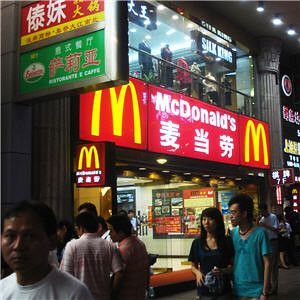By Natalie Curry and Jack Moran
Part III of Series on American Food In China
Americanized Chinese Food Part I, Part II

Is China turning into America? As tourists flood into China some locals are concerned that “China in the future would be turned into an America of the present” (Notar 20). As James Watson presents in his article on McDonalds in China, some have gone so far to say that the expansion of McDonalds is a “new form of imperialism” (Watson, 121). The documentary film Big Mac: Inside the McDonald’s Empire brings up the point that in a McDonalds restaurant in China it is nearly impossible to tell that one is actually in China, everything is the same as it would be in an American McDonalds with some minor signage/language differences. McDonalds is one of many American fast food chains that have grown exponentially in the past decade or so in China, and while these chains were once “a symbol of the decadent west” they are now a part of everyday life (Big Mac: Inside the McDonald’s Empire). This fast food chain has not grown just quickly, it has grown at light-speed over the past couple of years. According to an article in the Huffington Post, McDonalds planed to open a new store every single day. That is a lot of burgers! (Huff Post, 2011) Indeed it is difficult to ignore that in 2009 there were 800 McDonalds in China and currently there are more than 2000 McDonalds restaurants (Big Mac: Inside the McDonald’s Empire). What might come surprising to many, however, is that only six percent of these outlets are franchised by McDonalds (Huff Post, 2011). That means that 97% of those stores are owned and run by the Chinese themselves.
That many people own their own stores, but is it really the owners fault that McDonalds is growing so rapidly? Or is it the culture change that is happening within the great nation? James Watson wrote a book entitled “Golden Arches East” in 2006, to show the rapid rise of McDonalds in Asia. In chapter one, Watson writes, “The representation of McDonald’s as a symbol of American culture not only has drawn Beijing customers to new forms of dining but also has led them to accept new patterns of behavior.” (Watson, 2006) The American culture has been on a rise in China for awhile now and that could be the very reason why this fast food chain, the most famous fast food chain in the world today, is becoming the new spot for Chinese natives to go and grab a quick bite to eat.
The topic of American fast food chains is discussed further in the second part of this blog series on American food in China. Despite the influx of American businesses into China, I believe that the strength and history of Chinese culture and the uniqueness of the different regions of China will stop a complete homogenization of Chinese culture. Regardless of what the future holds, the present fact is that Americans and their consumer desires are having an effect on the Chinese market. Additionally, change is happening so rapidly in China that it is nearly impossible to predict what the future holds for China in the coming decades.
Works Cited
Big Mac: Inside the McDonald’s Empire. DVD. 2007; New York, NY: Films Media Group, 2008. http://alcuin.furman.edu:80/record=b3072954~S2
Notar, Beth E., Displacing Desire: Travel and Popular Culture in China. Honolulu: University of Hawaii Press. 2006. 20-46. http://alcuin.furman.edu:80/record=b1571313~S1
Watson, James L. “China’s Big Mac Attack.” Foreign Affairs 79, no. 3 (May 2000): 120-134. Academic Search Premier, EBSCOhost. http://search.ebscohost.com.libproxy.furman.edu/login.aspx?direct=true&db=aph&AN=3008927&site=ehost-live
“McDonald’s China Plans to Open Store Every Day in Four Years.” The Huffington Post. The HuffingtonPost.com Inc, n.d. Web. 21 Apr. 2015.
Watson, James. Golden Arches East: McDonald’s in East Asia. N.p.: Stanford University Press, 2006. Print.

Hi, i think it’s a good topic. i like your perspective. Good job!